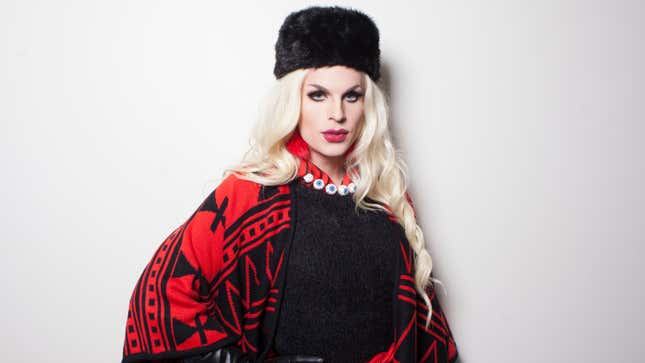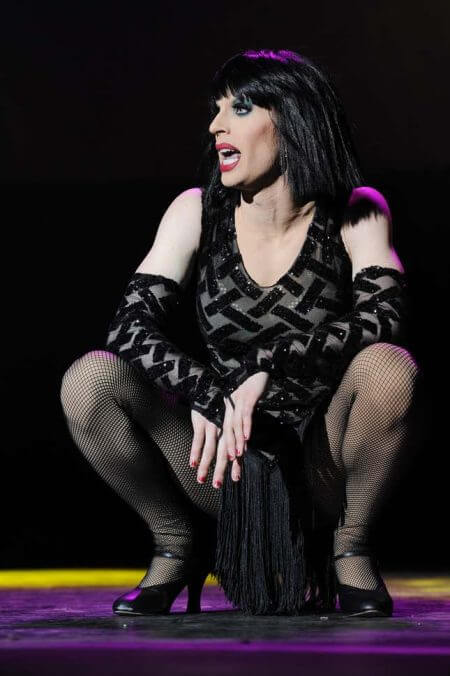Drag Race Alum Katya Zamolodchikova Revels in the Embarrassment of Being Alive
Entertainment
Image: Getty
Laurel Park is an idyllic, tucked-away pocket of West Hollywood, the front portion of a historic neighborhood home that was turned into public space in 2011. The colonial mansion was purchased in 1924 by pioneering cinema exhibitor Adolph Linick, a relic of the city’s legacy, but on a sticky early December afternoon, the park is mostly filled with women in leggings walking small dogs. It is not exactly the kind of place you’d expect to find two people talking about the perils of at-home anal waxing, but that’s what beloved RuPaul’s Drag Race alumnus Katya Zamolodchikova and I are doing. “It’s horrible! HOR-I-BLE,” she says smacking the picnic table we’re sitting at between each syllable. If you know Katya from TV or, maybe more likely, YouTube, then animated candor is what you’re expecting. This is how Katya does: she’s lighthearted and a little gross, salacious but kind of silly about it; she repeats, over and over, the words or phrases she wants to emphasize until she’s tried each on in the right tone of voice; she’s the kind of person whose creative output gets called “a beautiful obscenity” by the Godfather of Filth, John Waters.
Her frank and charming out-of-drag confessional interviews—and the bravery it took to talk about her addiction to alcohol, cocaine, and crystal meth—on Season 7 of Drag Race were what endeared her to the public in the first place. Voted Miss Congeniality of her season because of her authentic ability to float between the aesthetic-curious younger queens and the traditional old guard, she made it to the top 5 and was runner-up on All-Stars 2 the following year. Her loss is still considered an upset to fans, who wait hours on her meet-and-greet lines at events like RuPaul’s DragCon and the U.K. convention Dragworld. Last year, a teen brought her roommate’s freeze-dried amputated leg for Katya to pose with during a pre-show photo op; her fans—a lot of them teen girls— hang onto her eccentricities. “When I started touring, I used to sign every headshot I had with Bush did 9/11 for like two years. Last week I posted this thing about blush and someone responded ‘Blush did 9/11,’” she says.
“There’s no peeing in drag.”
But right now is a time for rest. “I’m just sleeping, eating, going to the bathroom,” she says. Wouldn’t her work-life include going to the bathroom? “There’s no peeing in drag,” she says, shaking her head.
Before this extended bathroom break, which ends with a short U.K. jaunt in February, Katya spent 2019 on the road with a solo show called Help Me, I’m Dying. The show is a pastiche of her lip-synching (both in Russian and English), monologuing, and engaging with the crowd, which she does as a character called Trish. Katya says the Trish portion of the show is very broad and slap-sticky, but the material from which Trish comes, a 10-video series titled Irregardlessly Trish, is a lot more focused and one of the best things Katya has ever done. It is pseudo-vérité that follows a dumpster-living, AA-evading trainwreck with a thick Boston accent and a permanent vat of Dunkin Donuts iced coffee who cuts hair out of her mom’s garage. In each video, Trish meanders through her city, opining about womanhood, addiction, and the embarrassment of being alive—it’s existentialism espoused with wet brain.
Katya’s ability to volley between these characters is likely a product of her conceptual art studies at Massachusetts College of Art in the early 2000s. She describes the work she did in school as “good old ’70s performance art” and cites the radical mundanity of the Judson Dance Theatre and audience antagonism of Merce Cunningham as influences. Lip syncing became part of her oeuvre after she and a few of her art school friends went to see David Lynch’s Mulholland Drive. A scene in which singer Rebekah del Rio lip-syncs to her own Spanish cover Roy Orbison’s “Crying” before passing out on the stage summed up Katya’s artistic ethos and reflected it back to her from the screen. “I watch that scene now and I’m like, this is what I like about performance art: having this crazy reaction to something and it’s not real,” she says. “You are being tricked the whole time.”

Mulholland Drive makes its way into Help Me, I’m Dying by way of a parody of another famous scene, one that takes place in a diner and ends with a trash monster, which Katya reenacts with fellow Drag Race favorite Trixie Mattel. Another video riffs on Cersei’s walk of shame in Game of Thrones, and there’s also a clip from Katya’s college days, one set to Mariah Carey in which Katya’s in love with Harrison Ford. “It was fun to bring that all back because it happened so long before Drag Race, but it was very Drag Race,” Katya says of the intersection of camp and pop music. “I love ironic shmaltz.”
The deconstruction of gender has been a throughline in Katya’s work from her time in art school before she was a Ru Girl to now. She describes a piece she did in college: “I was in a prom dress, no makeup, lip-syncing to ‘I Wanna Dance With Somebody’ by Whitney Houston and showing a slideshow of post-op transsexual vaginas. It was funny and then it was serious and then it was funny again.” As a performer at Jacques Cabaret, where she worked from 2006 until 2013, she took part in a monthly alt-drag revue called TraniWreck and performed on weekends for bachelorettes. Katya eventually got her own night, Perestroika. “It was a great alternative gay nightlife community thing. I know people who met their husbands there and went on to get married. It was the place to be,” she says, recalling that even Harvard and MIT faculty would show up. “The best drag number I ever did there was to the Russian version of ‘My Heart Will Go On’ from Titanic. I dressed as a boat. I spent weeks making a boat and my friend Mallory came out as an iceberg.”
Between the fundraising for Help Me, I’m Dying and the start of the actual tour, Katya and Trixie started UNHhhh, a YouTube series helmed by Drag Race production company World of Wonder. The show has a simple premise: the queens sit in front of a green screen and riff on topics like online dating and video games. The chemistry between the two is loving and chaotic, non-sequiturs ranging from childhood memories to outlandish perversion and bathroom humor abound. A lot from the magic comes from the editors who go to absurd depths to punch in graphics and animation that heighten the show’s fatuousness. In an episode about shopping, Katya explains to Trixie that her older sister found an abandoned piece of fecal matter in a dressing room at a job at the Fashion Bug. Smash cut to an animated turd trying on a dress, relieved to have finally found the right one.
It’s compelling to watch two people reveal the usually-private goofiness of an extremely deep friendship. Trixie and Katya are no-holds-barred on UNHhhh, whether they’re talking about venereal diseases or childhood trauma. Their secret language is their fans’ secret language and their following is so loyal that nearly anything said on the show can become part of the UNHhhh fan lexicon.
In 2017, after two seasons of UNHhhh, Viceland premiered The Trixie & Katya Show, a softer version of their show with the same editors. It lasted only one season on the network, but Katya suffered mental health and drug addiction issues and was off the show after episode 9.
The falling apart of Trixie & Katya and the temporary rift between the pair is cataloged in Trixie’s new documentary Moving Parts, which debuted at the Tribeca Film Festival last April and is now available digitally. “I think the documentary is cool in the sense that it’s so grey—it’s about this crossdressing Barbie character and the reality is so bleak,” Katya says. “I was really conflicted at the time. When I was actively crazy and I was like, Why is that camera here? I’m not getting paid for that. I don’t wanna be content in your fucking thing. I felt that I was being taken advantage of while I was nuts. Watching it was horrendous.”
It’s easy to recognize Katya’s behavior in Moving Parts if you have ever had a problem with booze or drugs. In particular in a scene where Trixie receives a barrage of mean-spirited texts from Katya, the kind that would blow up any relationship. “I did say all those things, I did write all those things. It’s true, so I don’t really have a problem with the truth but I don’t feel required to share my truth,” she says. “There’s absolutely no moral imperative to make the truth public.”
Moving Parts ends with Trixie and Katya’s friendship repaired, the two backstage at one of Trixie’s concerts at The Wiltern in LA, but the version of Katya on-screen is skittering, like a rescue animal adapting to a new home.
Trixie and Katya have repaired their friendship and their creative partnership is at an all-time high. In November, Netflix debuted I Like to Watch, a web series in which Trixie and Katya react to the streaming service’s original movies and series like Waldorf and Statler, only blonde wigged and lacquered. In May, their satirical etiquette guide Trixie & Katya’s Guide to Modern Womanhood will be published by Penguin Random House imprint Plume. “There are so many shitty books out there, so feels really good to put something out there that is not just another piece of shitty merchandise,” she says. “It was a good first project for first-time authors because just the act of sitting down and writing comedy is so hard.” She’s now working on a proposal for her own book of essays. It’s certain to have the same irreverence as the rest of her output, with and without Trixie, but perhaps nothing as berserk as Modern Womanhood’s most unhinged element: a photo of a swaddled Trixie breastfeeding from Katya who wears a tittie bib covered in bubblegum pink lipstick prints. (Katya is set to release a lipstick through Trixie Cosmetics called Red Scare this year.)
A couple of weeks after we meet, Katya tweets, “I was planning on seeing Cats but then I remembered that I performed a lip sync to the Russian version of [“Memory”] in a litter box 10 years ago.” On YouTube, there is a full video, filmed at Perestroika on an iPad from the DJ booth, and it’s the perfect pre-fame encapsulation of Katya’s deranged femininity. It’s distortion for the sake of comedy, grotesque in the literal sense of the word. Dressed in a spotted bodysuit like a furry’s hairless sex doll, Katya preens on the stage, pretending to groom herself before prancing through the club to retrieve her tips. The finale finds her filling a large plastic tub with two bags of litter. She climbs into the box to pantomime the song’s belter ending and the audience completely loses it. That is Katya’s perennial gift—conjuring joy from something shitty.
Claire Lobenfeld is a writer and community organizer based in Los Angeles.